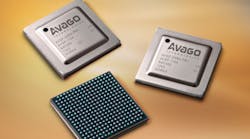The AVSP-1104 joins the Avago Technologies Vortex Gearbox family of physical-layer (PHY) transceivers. This flexible, programmable interface can be configured multiple ways to match data streams into and out of data center equipment like routers, switches, and blade servers using 100-Gbit/s Ethernet or Optical Transport Network (OTN).
A gearbox is essentially a kind of multiplexer/demultiplexer that’s used to convert multiple serial data streams at one rate to multiple streams at another rate. Serial-to-parallel and parallel-to-serial (SERDES) converters are at the heart of the device. SERDES converters are a specialty of Avago, which has been making them in various forms for years.
The AVSP-1104’s full duplex 10:4 or 4:10 gearbox mode is useful when connecting an ASIC or FPGA to a backplane or cable (see the figure). The IC can convert four lanes of 25 Gbits/s or 28 Gbits/s to 10 lanes of 10 Gbits/s or vice versa. In another mode, the device can serve as a 10:10 repeater or retimer. The IC can be use to drive optical modules, backplanes, or copper cables.
The device offers programmable Tx/Rx equalization of all SERDES using Avago’s proprietary decision feedback equalization (DFE) and long-reach performance that can withstand up to 32-dB channel loss. It also has a bit error rate (BER) of 1 x 10–20 and includes diagnostic software for remote debugging. It complies with IEEE CAUI and Common Electrical Interface (CEI) standards CEI-11G-SR and CEI 28G-VSR, and CEI 25G-LR. And, it boasts low power consumption and low latency.
The AVSP-1104 is made with 28-nm CMOS and comes in a 320-pin flip-chip ball-grid array (fcBGA) package. Samples are available now. Production is slated for March 2013.
Avago Technologies
www.avagotech.com/asics/vortex
Caption
The Avago Technologies AVSP-1104 programmable gearbox PHY is designed for use with 100-Gbit/s Ethernet or OTN optical modules, backplanes, or copper cables. Its 10:4 and 4:10 modes switch between 25 Gbits/s or 28 Gbits/s and 10 Gbits/s.

